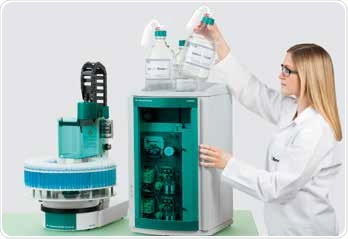Reliable and accurate determination of elemental composition, chemical binding, and oxidation states is important for evaluating toxicity in environmental analysis, medical and pharmaceutical analysis, water quality control, and the food and beverage industry.
In order to safeguard the basis of our own existence, it has become ever more important to monitor the environment for the presence of hazardous substances and to insist on better quality control and process control in the production of consumer products such as pharmaceuticals and foodstuffs. Online hyphenation of ion chromatography (IC) to inductively coupled plasma mass spectrometry (ICP/MS) provides an excellent method for such controls. This robust instrumental tool can be used to handle some of the most difficult analytical tasks.
The ICP/MS technique can establish the total amount of an element present in a sample with excellent detection limits (element selectivity). IC handles species selectivity, which means it is capable of separating ionic analytes based on their chemical structure (Herrmann, T.; 2006). Therefore, the online hyphenation of IC with ICP/MS integrates the molecular sensitivity of IC with the elemental sensitivity and selectivity of ICP/MS (Knöll, J.; 2013). Toxicity relies on both elemental composition and bioavailability, which is affected by the chemical binding and oxidation states inside the molecule. IC-ICP/MS allows reliable and accurate determination of these parameters.
Online hyphenation of a high-performance IC to an ICP/MS significantly increases sensitivity, as well as minimizing potential matrix interferences. Therefore, IC-ICP/MS is a powerful instrumental tool for speciation investigations in complex matrices. This article presents some of the most popular applications of IC-ICP/MS.
Norms and standards
There is an ever-increasing number of norms arising that require quantification of pollutants such as bromated or hexavalent chromium at low concentrations. Listed in Table 1 are norms and standards that propose IC-ICP/MS as a test method.
Table 1. Selection of standards that suggest IC-ICP/MS as a test method
|
Norm
|
Matrix
|
Analyte
|
Detection limit
|
|
DIN EN 71 - 3 (2013)
Safety of toys - Part 3: Migration of certain elements
|
Various toy materials in the categories
a) threadbare b) dry, brittle, dusty c) liquid
|
Chromium(VI)
|
a) 0.2 mg/kg
b) 0.02 mg/kg
c) 0.005 mg/kg
|
|
SN/T 2210-2008
Determination of hexavalent chromium in health foods
– IC-ICP/MS method
|
Foodstuffs
|
Chromium(VI)
|
|
|
EPA Method 321.8
Determination of bromate in drinking waters by ion
chromatography inductively coupled plasma mass
spectrometry
|
Potable water
|
Bromate
|
0.3 μg/L
|
|
ASTM C1845
Standard Practice for The Separation of Lanthanide Elements
from Uranium Matrices Using High Pressure Ion
Chromatography (HPIC) for Isotopic Analyses by Inductively
Coupled Plasma Mass Spectrometry (ICP-MS)
|
Dissolved uranium materials such as nuclear fuels, uranium ores, hydrolyzed UF6, and depleted, natural, or enriched oxides/ powders, or metals
|
Lanthanides
|
|
|
EPA SW-846, Method 6800
Elemental and speciated isotope dilution mass spectrometry
|
Hydrosphere, Biosphere
|
Hg, As, Cr
|
|
Ion chromatography instrumentation
Intelligent instruments that enable automated sample preparation, online sample introduction and logical decisions will become more and more important for hyphenated systems. Metrohm has set a new benchmark in IC with the 940 Professional IC Vario system, which provides excellent flexibility, complete reliability and the easiest operation.
Since the requirements towards the analysis instrument vary based on the structure of the sample matrix, the target analytes and the number of samples, a system that is fully modular by design provides a perfect solution. Such a system can meet existing requirements, whilst being adaptable for analytical challenges in the future.
Metrohm’s 940 Professional IC Vario system can automatically produce all solutions, including standards, if required. The system operates automatically right from the point of sample injection. It is also self-monitoring, which means all method and system parameters are always checked. In cases where maintenance is required by any system component, a warning is issued by the system.
This guarantees superior reliability of both the system and the analytical results it generates, by virtually eliminating operator errors. In addition, every result can be traced back to each step of the analysis, including sample preparation. Therefore, the IC system is ideal for complex scientific analyses, as well as serving as a powerful and easy-to-use tool for routine analysis.

The 940 Professional IC Vario system provides the following benefits:
- Almost unlimited possibilities for system configuration
- Modular high-performance IC system
- Highest sensitivity for lowest detection limits
- Small footprint, compact dimensions
- Designed for research applications and routine analyses from the ng/L to the % range
- Intelligent system components for accurate and reliable results
- Free choice of column and suppressor
- Broad range of detection options: Amperometry, conductivity, and UV/VIS
- All gradient options
- Inline eluent preparation incorporated in the system
- Complete automation for high sample throughput
- Compatible with the unique and partly patented Inline Sample Preparation techniques (MISP) from Metrohm
- Rugged Swiss quality
- Low maintenance costs and extended lifetime
- Multi-language MagIC Net software for simple and intuitive operation
- Complies with FDA and GLP regulations

ICP/MS instrumentation
One of the most robust methods for inorganic trace analysis is mass spectrometry with inductively coupled argon plasma. When there is a need for low detection limits, ICP/MS is better than ICP/AES. When compared to ionization of other elements, ionization of metals is more efficient and metal ions are therefore often used as analytes for this method.
ICP/MS is routinely employed for quality control in foodstuffs, trace analysis in environmental samples, as well as for quality control in biological and medical samples.
The advantages of the ICP/MS technique include (Herrmann, T.; 2006):
- Trace analysis with excellent limits of detection (pg/L range)
- Multi-element method for concurrent determination of virtually all elements of the periodic table
- Dynamic measuring range of over eight orders of magnitude
- Rapid, semi-quantitative analysis with high informative value for preliminary overviews
- Can determine isotopic ratios and of isotope dilution analysis
- Liquid, solid, and gaseous samples can be analyzed with the correct sample introduction/preparation for analysis
- Only a small amount of sample is needed
In the ICP/MS method, a plasma source is used to ionize the samples. The energy supply is provided by electric currents, created by electromagnetic induction. Here, time-varying electric current is passed through a coil, which produces a time-varying magnetic field that, in turn, produces the electric currents. A plasma is formed by the inductively heated gas (typically argon) when the concentration of its electrons and ions is enough to render the gas electrically conductive (Montaser, A.; 1992). As a result, the sample is ionized.
The ions generated are introduced into a vacuum through a number of stages. The ion beam is focused by skimmers and lenses. Based on their mass-to-charge ratio, ions are consecutively separated, as in any MS. Sector field, quadrupole, or time of-flight technology is utilized as mass analyzer. For routine analysis, quadrupoles are often used.
Conclusion
Remote control functionality is a feature of all advanced ICP/MS instruments, allowing data acquisition to be synchronized with IC instruments. This set-up is the most direct and straightforward when two different softwares are being used to operate the instruments. There are no limitations in terms of which instruments can be combined. Additional detectors such as UV/ VIS, amperometry or conductivity detectors from Metrohm can be easily combined via the IC and using digital-to-analog converters, the signals of these detectors can be transferred to the ICP/MS software.
References
- Aschner, M.; Syversen, T. (2005) Methylmercury: Recent advances in the understanding of its neurotoxicity. Ther. Drug Monit. 27, 278–283.
- Bianchi, A.; Calabi, L.; Corana, F.; Fontana, S.; Losi, Maiocchi, A.; Paleari, L.; Valtancoli, B. (2000) Thermodynamic and structural properties of Gd(III) complexes with polyaminopolycarboxylic ligands: Basic compounds for the development of MRI contrast agents. Coord. Chem. Rev. 204, 309–393
- Burger, J.; Gochfeld, M. (2005) Heavy metals in commercial fish in New Jersey. Environ. Res. 99(3), 403–412
- Dietary Supplement Fact Sheet: Selenium. US National Institutes of Health; Office of Dietary Supplements. Retrieved Oct 11, 2016.
- Gochfeld, M.; Burger, J. (2005) Good fish/bad fish: A composite benefit–risk by dose curve. Neurotoxicology 26(4), 511–520
- Herrmann, T. Einsatz der On-line-Kopplung von Ionenchromatographie und ICP-MS zur Bestimmung von Anionen. Diploma thesis, Philipps-Universität Marburg, Germany, 2006
- Knöll, J. Ph.D. Ultratrace determination of aminopolycarboxylic acid based chelating agents using inverse on-line coupling of IC with ICP-MS. PhD thesis, Philipps-Universität Marburg, Germany, 2013
- Knöll, J.; Seubert, A. (2012) Indirect ultra trace determination of aminopolycarboxylic acids in surface water using ion exchange chromatography coupled on-line to inductively coupled plasma mass spectrometry. Journal of Chromatography A 1270, 219-224.
- Kümmerer, K.; Ed. Pharmaceuticals in the environment: Sources, fate, effects, and risks. Springer-Verlag Berlin Heidelberg, 2008; 3rd ed.
- Künnemeyer, J.; Terborg, L.; Meermann, B.; Brauckmann, C.; Möller, I.; Scheffer, A.; Karst, U. (2009) Speciation analysis of gadolinium chelates in hospital effluents and wastewater treatment plant sewage by a novel HILIC/ICP-MS method. Environ. Sci. Technol. 43(8), 2884–2890.
- Künnemeyer, J.; Terborg, L.; Nowak, S.; Telgmann, L.; Tokmak, F.; Krämer, B. K.; Günsel, A.; Wiesmüller, G. A.; Waldeck, J.; Bremer, C.; Karst, U. (2009) Analysis of the contrast agent Magnevist and its transmetalation products in blood plasma by capillary electrophoresis / electrospray ionization time-of-flight mass spectrometry. Anal. Chem. 81(9), 3600–3607
- Levenson, C. W.; Axelrad, D. M. (2006) Too much of a good thing? Update on fish consumption and mercury exposure Nutr. Rev. 64(3), 139–145.
- Montaser, A.; Golightly, D. W.; Eds. Inductively coupled plasmas in analytical atomic spectrometry. VCH Publishers, Inc.: New York, 1992.
- Rahman, G. M. M.; Martone, N.; 'Skip' Kingston, H. M. (2012) Determination of hexavalent chromium in NIST SRM 2701 by speciated isotope dilution mass spectrometry (EPA Method 6800) using IC-ICP-MS. In Handbook of hyphenated ICP-MS applications, 2nd edition; Agilent, 2012; pp 33–35. http://www.agilent.com/cs/library/applications/5990-9473EN_icpmsSpeciationHB_lr.pdf (accessed Oct 7, 2016)
- Saranko, C. J. et al. Fact Report for toxicity of arsenite and arsenate, Florida Dept. of Health, Nov 6, 1998
- Schedlbauer, O. F.; Heumann, K. G. (2000) Biomethylation of thallium by bacteria and first determination of biogenic dimethylthallium in the ocean. Appl. Organomet. Chem.14(6), 330-340
- Wilber, C. G. (1980). Toxicology of selenium: A review.Clin. Toxicol. 17 (2), 171–230.
About Metrohm
At Metrohm is one of the world’s most trusted manufacturers of high-precision instruments for chemical analysis. Metrohm was founded in 1943 by engineer Bertold Suhner in Herisau, Switzerland. Today, Metrohm is represented in 120 countries by subsidiaries and exclusive distributors. The global Metrohm Group also includes the Dutch companies Metrohm Applikon and Metrohm Autolab, manufacturers of online analyzers and instruments for electrochemical research, respectively. Recently, the Metrohm Group was joined by Metrohm Raman, a leading manufacturer of handheld Raman spectrometers.
Metrohm is the global market leader in analytical instruments for titration. Instruments for ion chromatography, voltammetry, conductivity, and stability measurement make the Metrohm portfolio for ion analysis complete. Instruments for Near-infrared and Raman spectroscopy are another, strongly growing segment of the Metrohm portfolio.
Metrohm is a problem solver, both in the laboratory and within the industrial process. To this end, the company offers their customers complete solutions, including dedicated analytical instrumentation as well as comprehensive application know-how. More than 30% of the company’s employees at the Metrohm international headquarters in Herisau work in R&D.
Metrohm has been owned 100% by the non-profit Metrohm Foundation since 1982. The Metrohm Foundation, which does not exert any influence on the company’s business operations, sponsors gifted students in the natural sciences, supports charitable and philanthropic purposes and, above all, ensures the independence of the company.
Sponsored Content Policy: News-Medical.net publishes articles and related content that may be derived from sources where we have existing commercial relationships, provided such content adds value to the core editorial ethos of News-Medical.Net which is to educate and inform site visitors interested in medical research, science, medical devices and treatments.